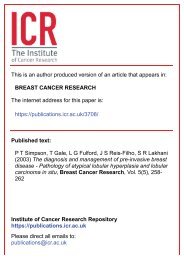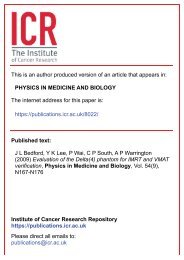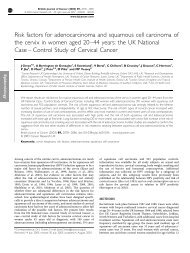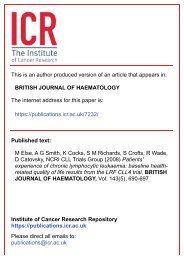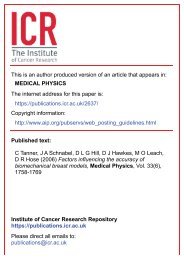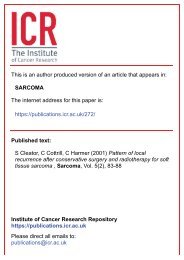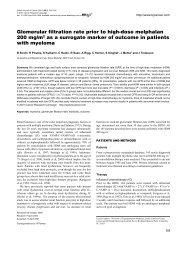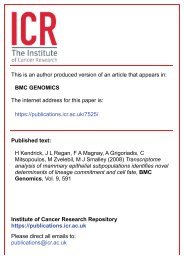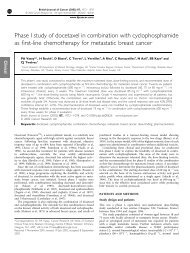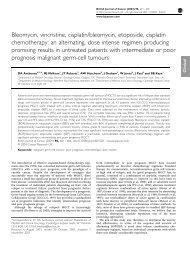Cancer risk in patients with constitutional chromosome deletions: a ...
Cancer risk in patients with constitutional chromosome deletions: a ...
Cancer risk in patients with constitutional chromosome deletions: a ...
Create successful ePaper yourself
Turn your PDF publications into a flip-book with our unique Google optimized e-Paper software.
British Journal of <strong>Cancer</strong> (2008) 98, 1929 – 1933<br />
& 2008 <strong>Cancer</strong> Research UK All rights reserved 0007 – 0920/08 $30.00<br />
www.bjcancer.com<br />
<strong>Cancer</strong> <strong>risk</strong> <strong>in</strong> <strong>patients</strong> <strong>with</strong> <strong>constitutional</strong> <strong>chromosome</strong> <strong>deletions</strong>:<br />
a nationwide British cohort study<br />
<br />
AJ Swerdlow* ,1 , MJ Schoemaker 1 , CD Higg<strong>in</strong>s 1 , AF Wright 2 and PA Jacobs 3 on behalf of the UK Cl<strong>in</strong>ical<br />
Cytogenetics Group<br />
1 Section of Epidemiology, Institute of <strong>Cancer</strong> Research, Sir Richard Doll Build<strong>in</strong>g, Cotswold Road, Sutton, Surrey SM2 5NG, UK;<br />
2 Cell and Molecular<br />
Genetics Section, MRC Human Genetics Unit, Crewe Road, Ed<strong>in</strong>burgh EH4 2XU, UK; 3 Wessex Regional Genetics Laboratory, Salisbury District Hospital,<br />
Salisbury, Wilts SP2 8BJ, UK<br />
The f<strong>in</strong>d<strong>in</strong>g of <strong>in</strong>creased <strong>risk</strong>s of specific cancers <strong>in</strong> <strong>in</strong>dividuals <strong>with</strong> <strong>constitutional</strong> <strong>deletions</strong> of <strong>chromosome</strong>s 11p and 13q led to the<br />
discovery of cancer predisposition genes at these locations, but there have been no systematic studies of cancer <strong>risk</strong>s <strong>in</strong> <strong>patients</strong> <strong>with</strong><br />
<strong>constitutional</strong> <strong>deletions</strong>, across the <strong>chromosome</strong> complement. Therefore, we assessed cancer <strong>in</strong>cidence <strong>in</strong> comparison <strong>with</strong> national<br />
cancer <strong>in</strong>cidence rates <strong>in</strong> a follow-up of 2561 <strong>patients</strong> <strong>with</strong> <strong>constitutional</strong> autosomal <strong>chromosome</strong> <strong>deletions</strong> diagnosed by microscopy<br />
or fluorescence <strong>in</strong> situ hybridisation <strong>in</strong> Brita<strong>in</strong> dur<strong>in</strong>g the period 1965–2002. Thirty cancers other than non-melanoma sk<strong>in</strong> cancer<br />
occurred <strong>in</strong> the cohort (standardised <strong>in</strong>cidence ratio (SIR) ¼ 2.4, 95% confidence <strong>in</strong>terval (CI) 1.6–3.5). There were significantly<br />
<strong>in</strong>creased <strong>risk</strong>s of renal cancer <strong>in</strong> persons <strong>with</strong> 11p <strong>deletions</strong> (SIR ¼ 1869, 95% CI 751–3850; P ¼ 4 10 21 ), eye cancer <strong>with</strong> 13q<br />
<strong>deletions</strong> (SIR ¼ 1084, 95% CI 295–2775; P ¼ 2 10 11 ), and anogenital cancer <strong>with</strong> 11q <strong>deletions</strong> (SIR ¼ 305, 95% CI 63–890;<br />
P ¼ 3 10 7 ); all the three latter cancers were <strong>in</strong> the 11 subjects <strong>with</strong> 11q24 <strong>deletions</strong>. The results strongly suggest that <strong>in</strong> addition<br />
to suppressor genes relat<strong>in</strong>g to Wilms’ tumour <strong>risk</strong> on 11p and ret<strong>in</strong>oblastoma on 13q, there are suppressor genes around 11q24<br />
that greatly affect anogenital cancer <strong>risk</strong>.<br />
British Journal of <strong>Cancer</strong> (2008) 98, 1929–1933. doi:10.1038/sj.bjc.6604391 www.bjcancer.com<br />
Published onl<strong>in</strong>e 27 May 2008<br />
& 2008 <strong>Cancer</strong> Research UK<br />
Keywords: <strong>constitutional</strong> <strong>chromosome</strong> <strong>deletions</strong>; cohort; <strong>risk</strong><br />
Cl<strong>in</strong>ical Studies<br />
Visible <strong>constitutional</strong> <strong>chromosome</strong> <strong>deletions</strong> are present <strong>in</strong> about<br />
0.5–1 <strong>in</strong> 10 000 newborn babies (Hamerton et al, 1975; Jacobs et al,<br />
1992). Such <strong>deletions</strong> can give <strong>in</strong>formation <strong>in</strong> a unique way about<br />
the function and consequences of the genes on the parts of the<br />
<strong>chromosome</strong> deleted. Thus, if tumour suppressor genes play an<br />
important role <strong>in</strong> the <strong>risk</strong> of a type of cancer, it might be expected<br />
that the <strong>risk</strong> of that cancer would be <strong>in</strong>creased <strong>in</strong> <strong>in</strong>dividuals who<br />
have <strong>deletions</strong> that <strong>in</strong>clude the relevant gene. The cells of most<br />
malignancies show <strong>chromosome</strong> abnormalities, many of which<br />
are specific to a particular tumour type(s), frequently the loss of a<br />
specific chromosomal band or segment (Yunis, 1983; Gaspar<strong>in</strong>i<br />
et al, 2007); deletion of tumour suppressor genes is <strong>in</strong>creas<strong>in</strong>gly<br />
regarded as a key <strong>in</strong>itiat<strong>in</strong>g event <strong>in</strong> epithelial tumours (Gaspar<strong>in</strong>i<br />
et al, 2007). Increased <strong>risk</strong>s of certa<strong>in</strong> cancers <strong>in</strong> <strong>patients</strong> <strong>with</strong><br />
<strong>constitutional</strong> <strong>chromosome</strong> <strong>deletions</strong> have led to the identification<br />
of cancer loci – 13q14 <strong>deletions</strong> for ret<strong>in</strong>oblastoma and 11p13<br />
<strong>deletions</strong> for Wilms’ tumour – and it is also important to know<br />
about them for cl<strong>in</strong>ical care and surveillance and for giv<strong>in</strong>g advice<br />
to <strong>patients</strong> and their relatives.<br />
No studies, however, appear to have <strong>in</strong>vestigated systematically<br />
cancer <strong>risk</strong>s <strong>in</strong> <strong>patients</strong> <strong>with</strong> <strong>deletions</strong> of each <strong>chromosome</strong> and<br />
arm. A Danish cohort study (Bache et al, 2006) <strong>in</strong>vestigated cancer<br />
<strong>in</strong>cidence <strong>risk</strong> <strong>in</strong> <strong>patients</strong> <strong>with</strong> <strong>deletions</strong> overall but did not divide<br />
*Correspondence: Professor AJ Swerdlow;<br />
E-mail: anthony.swerdlow@icr.ac.uk<br />
Received 23 January 2008; revised 9 April 2008; accepted 9 April 2008;<br />
published onl<strong>in</strong>e 27 May 2008<br />
the analysis by <strong>chromosome</strong>, and a US cohort study analysed<br />
cancer <strong>in</strong>cidence <strong>risk</strong>s <strong>in</strong> the first 4 years of life <strong>in</strong> <strong>patients</strong> <strong>with</strong><br />
Beck<strong>with</strong>–Wiedemann syndrome (DeBaun and Tucker, 1998).<br />
Several studies have <strong>in</strong>vestigated the frequency of <strong>chromosome</strong><br />
abnormalities <strong>in</strong> <strong>patients</strong> <strong>with</strong> haematological malignancy (Benitez<br />
et al, 1987; Cerret<strong>in</strong>i et al, 2002; Welborn, 2004), but <strong>with</strong> far too<br />
few <strong>deletions</strong> to assess whether <strong>risk</strong> is altered for <strong>deletions</strong> on<br />
specific <strong>chromosome</strong>s.<br />
Therefore, we undertook a national cohort study of cancer<br />
<strong>in</strong>cidence <strong>in</strong> <strong>patients</strong> <strong>with</strong> <strong>chromosome</strong> <strong>deletions</strong> diagnosed by<br />
light microscopy or fluorescence <strong>in</strong> situ hybridisation (FISH) <strong>in</strong><br />
Brita<strong>in</strong> dur<strong>in</strong>g the past 40 years.<br />
MATERIALS AND METHODS<br />
From all 27 cytogenetic laboratories <strong>in</strong> Brita<strong>in</strong> except two small<br />
laboratories, we extracted <strong>in</strong>formation about all live-born <strong>patients</strong><br />
diagnosed <strong>with</strong> autosomal <strong>chromosome</strong> <strong>deletions</strong> detectable on<br />
light microscopy or by FISH s<strong>in</strong>ce the laboratories opened or from<br />
as long ago as records had been ma<strong>in</strong>ta<strong>in</strong>ed. Ethical approval was<br />
obta<strong>in</strong>ed from the relevant ethics committees. We excluded from<br />
the cohort <strong>patients</strong> whose cytogenetic records showed that they<br />
had been karyotyped because of cancer and also <strong>patients</strong> <strong>with</strong> a<br />
deletion plus trisomy, because the latter may be related to cancer<br />
<strong>risk</strong> <strong>in</strong> its own right.<br />
Information regard<strong>in</strong>g identification of the cohort members was<br />
sent to the National Health Service Central Registers (NHSCRs) for
Cl<strong>in</strong>ical Studies<br />
1930<br />
England and Wales and for Scotland. These registries had records<br />
of all NHS <strong>patients</strong> of their respective countries and, consequently,<br />
are virtually complete population registers; they record deaths,<br />
emigrations, other exits from follow-up and, s<strong>in</strong>ce 1971, cancer<br />
registrations. The cohort members were ‘flagged’ on the registers<br />
to obta<strong>in</strong> <strong>in</strong>formation about cancer <strong>in</strong>cidence, deaths, and other<br />
follow-up. The sites of cancers were coded accord<strong>in</strong>g to the<br />
revision of the International Classification of Diseases (ICD)<br />
(World Health Organization, 1977) <strong>in</strong> force <strong>in</strong> Brita<strong>in</strong> at the time of<br />
<strong>in</strong>cidence: ICD8 from 1971 to 78, ICD9 from 1979 to 94 <strong>in</strong> England<br />
and Wales and from 1979 to 96 <strong>in</strong> Scotland, and ICD10 from 1995<br />
onwards <strong>in</strong> England and Wales and from 1997 onwards <strong>in</strong><br />
Scotland. We then bridge coded the cancer data (i.e. matched<br />
equivalent codes between different ICD revisions) to produce the<br />
ICD9 categories shown <strong>in</strong> the tables.<br />
To analyse cancer <strong>in</strong>cidence <strong>risk</strong>s <strong>in</strong> the cohort, we calculated<br />
person-years of follow-up by sex, 5-year age group, calendar year<br />
and country (England and Wales vs Scotland), beg<strong>in</strong>n<strong>in</strong>g from<br />
the date of cytogenetic diagnosis or 1 January 1971, whichever was<br />
latest, and end<strong>in</strong>g on 31 December 2004 (the date up to which<br />
national cancer registration data were reasonably complete at<br />
the time of analysis) or the date of death, emigration, other loss<br />
to follow-up or 85th birthday, whichever occurred first. Nonmelanoma<br />
sk<strong>in</strong> cancer was excluded from analysis because its<br />
registration was seriously <strong>in</strong>complete (Swerdlow et al, 2001).<br />
Follow-up was censored at age 85 because at older ages cancer<br />
diagnosis is likely to be <strong>in</strong>complete and <strong>in</strong>accurate, and national<br />
(i.e. expected) cancer <strong>in</strong>cidence rates are not available by 5-year<br />
age group. We then computed expected site-specific cancer<br />
<strong>in</strong>cidence <strong>in</strong> the cohort by multiply<strong>in</strong>g age-, sex-, calendar yearand<br />
country-specific person-years at <strong>risk</strong> <strong>in</strong> the cohort by the<br />
correspond<strong>in</strong>g national cancer <strong>in</strong>cidence rates. Standardised<br />
<strong>in</strong>cidence ratios (SIRs) were calculated as the ratio of observed<br />
to expected deaths, and 95% confidence <strong>in</strong>tervals (CIs) for the SIRs<br />
were calculated based on Fisher’s exact method (Breslow and Day,<br />
1987). All significance tests were two-sided. To assess the<br />
significance of the results allow<strong>in</strong>g for the fact that multiple<br />
test<strong>in</strong>g had been undertaken, we used the Bonferroni adjustment<br />
(Altman, 1991).<br />
To assess whether the apparent <strong>in</strong>crease <strong>in</strong> cancer <strong>in</strong>cidence<br />
might have been caused by selective cytogenetic diagnosis of<br />
persons ill <strong>with</strong> as yet undiagnosed cancer, or by imprecision <strong>in</strong><br />
the exact dates of cytogenetic and cancer diagnoses when these<br />
were close together, we exam<strong>in</strong>ed the duration between cytogenetic<br />
and cancer diagnosis for the cancers <strong>in</strong>cident dur<strong>in</strong>g cohort<br />
follow-up, and we reanalysed <strong>risk</strong>s omitt<strong>in</strong>g follow-up and cancers<br />
occurr<strong>in</strong>g <strong>in</strong> the year after cytogenetic diagnosis.<br />
RESULTS<br />
<strong>Cancer</strong> <strong>risk</strong> <strong>in</strong> <strong>patients</strong> <strong>with</strong> <strong>chromosome</strong> <strong>deletions</strong><br />
AJ Swerdlow et al<br />
From the records of the cytogenetic laboratories <strong>in</strong>cluded <strong>in</strong> the<br />
study, we identified 3212 <strong>patients</strong> <strong>with</strong> autosomal <strong>chromosome</strong><br />
<strong>deletions</strong> diagnosed dur<strong>in</strong>g 1965–2002. In most of the laboratories,<br />
cytogenetic records were available back to the 1960s or early 1970s,<br />
depend<strong>in</strong>g on the date when the laboratory was founded and how<br />
far back records had been reta<strong>in</strong>ed. Fifteen <strong>patients</strong> were excluded<br />
from the study because their cytogenetic test<strong>in</strong>g was undertaken as<br />
a consequence of a cancer diagnosis (5 <strong>patients</strong> <strong>with</strong> 13q <strong>deletions</strong><br />
and ret<strong>in</strong>oblastoma, 4 <strong>with</strong> 11p <strong>deletions</strong> and Wilms’ tumour), 68<br />
<strong>patients</strong> because the year of karyotyp<strong>in</strong>g was unknown, 517 cases<br />
because they could not be flagged, generally because the exact date<br />
of birth or full name was unknown and 22 <strong>patients</strong> were excluded<br />
for other reasons. There rema<strong>in</strong>ed 2561 subjects who were flagged<br />
at the NHSCRs and who comprised the study cohort. Twenty-four<br />
of these subjects had been identified from the research-based<br />
register of the MRC Human Genetics Unit and the other 2537 from<br />
registers of cl<strong>in</strong>ical diagnostic laboratories.<br />
The <strong>patients</strong> <strong>in</strong>cluded <strong>in</strong> the cohort were ma<strong>in</strong>ly diagnosed at<br />
ages under 15 years (79%) and there were slightly more female<br />
<strong>patients</strong> than male <strong>patients</strong> (52 vs 48%, respectively); most were<br />
diagnosed <strong>in</strong> 1990 or later (81%) and only 3% before 1980<br />
(Table 1). The most common <strong>deletions</strong> were those of 22q, 15q, 7q,<br />
5p and 17p. The 651 subjects <strong>with</strong> autosomal <strong>deletions</strong> who were<br />
diagnosed at the study centres but not flagged and not <strong>in</strong>cluded <strong>in</strong><br />
the cohort (not <strong>in</strong> table) had a similar sex and age distribution to<br />
the cohort members except that they <strong>in</strong>cluded a somewhat greater<br />
proportion of <strong>in</strong>fants and they <strong>in</strong>cluded all subjects of unknown<br />
age (i.e. those <strong>with</strong> an unknown date of birth, which made flagg<strong>in</strong>g<br />
impossible and therefore led to exclusion from the cohort).<br />
A total of 252 subjects died dur<strong>in</strong>g follow-up, 42 emigrated or<br />
were otherwise lost to follow-up and 2267 survived to the end of<br />
follow-up or to age 85. The cohort members were followed-up for a<br />
total of 27 386 person-years, an average of 10.5 years per subject.<br />
Thirty-two cancers were recorded as occurr<strong>in</strong>g <strong>in</strong> the cohort<br />
(Table 2), of which two were non-melanoma sk<strong>in</strong> cancers and were<br />
excluded from analysis. <strong>Cancer</strong> <strong>risk</strong> was significantly <strong>in</strong>creased <strong>in</strong><br />
the cohort (SIR ¼ 2.4, 95% CI 1.6–3.5), largely because of greatly<br />
<strong>in</strong>creased <strong>risk</strong>s of renal, eye and female genital cancers and of<br />
leukaemia. The cod<strong>in</strong>g of cancers <strong>in</strong> the national data (i.e. the<br />
‘expected’ rates for this study) does not enable analysis of <strong>risk</strong>s of<br />
Wilms’ tumour and ret<strong>in</strong>oblastoma per se, but all of the renal and<br />
eye cancers occurr<strong>in</strong>g <strong>in</strong> the cohort were these two tumours,<br />
respectively. In total, five anogenital cancers occurred <strong>in</strong> the<br />
cohort (SIR ¼ 8.5, 95% CI 2.7–19.7): two vulval, one vag<strong>in</strong>al, one<br />
anal and one cervical.<br />
When we analysed cancer <strong>risk</strong>s by the <strong>chromosome</strong> and arm of<br />
deletion, all 8 renal cancers were <strong>in</strong> the 50 <strong>patients</strong> <strong>with</strong> 11p<br />
<strong>deletions</strong>, all 4 eye cancers were <strong>in</strong> the 82 <strong>patients</strong> <strong>with</strong> 13q<br />
<strong>deletions</strong> and there were 3 anogenital cancers (2 vulval, 1 anal) <strong>in</strong><br />
the 36 <strong>patients</strong> <strong>with</strong> 11q <strong>deletions</strong>. Table 3 shows <strong>risk</strong>s of these<br />
tumours by sex and age. Renal cancer <strong>risk</strong> <strong>in</strong> subjects <strong>with</strong> 11p<br />
<strong>deletions</strong> was almost 2000-fold <strong>in</strong>creased (SIR ¼ 1869, 95% CI<br />
751–3850; P ¼ 4 10 21 ), and was comparably <strong>in</strong>creased <strong>in</strong> male<br />
and female subjects; all cases occurred at ages under 5 years, for<br />
which the SIR was almost 4000. The <strong>risk</strong> of eye cancer <strong>in</strong> subjects<br />
<strong>with</strong> 13q <strong>deletions</strong> was 1084 (P ¼ 2 10 11 ). The relative <strong>risk</strong> of<br />
vulval and vag<strong>in</strong>al cancer <strong>in</strong> <strong>patients</strong> <strong>with</strong> 11q <strong>deletions</strong> was 2930<br />
(P ¼ 5 10 7 ) and of the wider category of anogenital cancers it<br />
was 305 (P ¼ 3 10 7 ). All of these SIRs rema<strong>in</strong>ed highly<br />
significant (Po0.001) after application of a Bonferroni adjustment.<br />
The renal cancers all occurred <strong>in</strong> <strong>patients</strong> <strong>with</strong> <strong>deletions</strong> that<br />
encompassed 11p13, except one <strong>with</strong> a break at 11p14. The eye<br />
cancers were all <strong>in</strong> <strong>patients</strong> <strong>with</strong> <strong>deletions</strong> encompass<strong>in</strong>g 13q14<br />
except that for one the breakpo<strong>in</strong>t was not specified. The two vulval<br />
cancers and the anal cancer <strong>in</strong> <strong>patients</strong> <strong>with</strong> <strong>deletions</strong> of 11q all<br />
occurred <strong>in</strong> subjects <strong>with</strong> <strong>deletions</strong> of 11q24 and were all of<br />
squamous cell histology. The vulval cancers occurred at ages 22 and<br />
36 years and the anal cancer at age 46 years; the breakpo<strong>in</strong>ts for the<br />
vulval cancer <strong>patients</strong> were recorded as 11q24.2; for the anal cancer,<br />
no further precision beyond 11q24 was recorded. The vag<strong>in</strong>al cancer<br />
was an adenocarc<strong>in</strong>oma and occurred <strong>in</strong> a patient <strong>with</strong> a deletion of<br />
22q11; the cervical cancer was a squamous cell cancer <strong>in</strong> a patient<br />
<strong>with</strong> a 15q deletion. There were 36 subjects <strong>in</strong> the cohort <strong>with</strong> 11q<br />
<strong>deletions</strong>, of whom 11 were known to have an 11q24 breakpo<strong>in</strong>t, 21<br />
to have <strong>deletions</strong> <strong>with</strong> breakpo<strong>in</strong>t(s) elsewhere on the arm and 4<br />
<strong>with</strong> <strong>deletions</strong> of unknown breakpo<strong>in</strong>t(s).<br />
The four cases of leukaemia occurred <strong>in</strong> <strong>patients</strong> <strong>with</strong> different<br />
<strong>deletions</strong>: one ALL <strong>in</strong> a patient <strong>with</strong> an 8p deletion, one AML <strong>in</strong> a<br />
patient <strong>with</strong> a 20q deletion, one acute leukaemia NOS <strong>in</strong> a patient<br />
<strong>with</strong> a deletion on <strong>chromosome</strong> 5 and one CML <strong>in</strong> a patient <strong>with</strong><br />
an 18q deletion. Likewise, the two testicular cancers were<br />
heterogeneous: one <strong>in</strong> a man <strong>with</strong> a 15q deletion and the other<br />
<strong>in</strong> a man <strong>with</strong> an 18q deletion.<br />
All but one of the eight renal cancers (Wilms’ tumours) occurred<br />
at least a year after cytogenetic diagnosis of a <strong>constitutional</strong><br />
British Journal of <strong>Cancer</strong> (2008) 98(12), 1929 – 1933<br />
& 2008 <strong>Cancer</strong> Research UK
Table 1<br />
deletion<br />
Cohort by sex, age at diagnosis, and <strong>chromosome</strong> and arm of<br />
Male Female Total<br />
No. No. No.<br />
Age at diagnosis (years)<br />
o1 413 422 835<br />
1 –14 591 595 1186<br />
15 – 24 98 128 226<br />
X25 123 191 314<br />
Year of diagnosis<br />
o1980 20 49 69<br />
1980 – 89 189 229 418<br />
X1990 1016 1058 2074<br />
Chromosome and arm of deletion<br />
1p 9 13 22<br />
1q 12 15 27<br />
2p 7 4 11<br />
2q 44 51 95<br />
3p 6 6 12<br />
3q 7 12 19<br />
4p 37 47 84<br />
4q 34 40 74<br />
5p 57 83 140<br />
5q 13 16 29<br />
6p 8 6 14<br />
6q 22 13 35<br />
7p 5 4 9<br />
7q 108 102 210<br />
8p 18 19 37<br />
8q 10 6 16<br />
9p 23 34 57<br />
9q 10 7 17<br />
10p 7 3 10<br />
10q 23 29 52<br />
11p 24 26 50<br />
11q 14 22 36<br />
12p 4 5 9<br />
12q 3 4 7<br />
13q 37 45 82<br />
14q 8 8 16<br />
15q 237 223 460<br />
16p 4 3 7<br />
16q 5 7 12<br />
17p 61 62 123<br />
17q 6 0 6<br />
18p 27 32 59<br />
18q 48 69 117<br />
19p 3 0 3<br />
19q 0 0 0<br />
20p 4 8 12<br />
20q 2 0 2<br />
21q 11 10 21<br />
22q 261 283 544<br />
Not known a 6 19 25<br />
Total 1225 1336 2561<br />
a Either deletion of known autosome but unknown arm or deletion of known<br />
<strong>chromosome</strong> group (e.g. C) but unknown specific <strong>chromosome</strong>.<br />
deletion, as did all of the anogenital cancers (<strong>in</strong>deed, the earliest<br />
of these was 7 years after cytogenetic diagnosis). Two of the four<br />
leukaemias and all of the eye cancers (ret<strong>in</strong>oblastomas) were<br />
recorded as occurr<strong>in</strong>g <strong>with</strong><strong>in</strong> a year after the cytogenetic diagnosis,<br />
but the eye cancers all occurred at ages under 6 months, so only<br />
periods shorter than this between the two diagnoses were possible.<br />
When <strong>risk</strong>s were reanalysed exclud<strong>in</strong>g the first year of followup,<br />
the <strong>risk</strong> of cancer (exclud<strong>in</strong>g non-melanoma sk<strong>in</strong> cancer)<br />
overall <strong>in</strong> the cohort rema<strong>in</strong>ed significantly <strong>in</strong>creased (SIR ¼ 1.9,<br />
<strong>Cancer</strong> <strong>risk</strong> <strong>in</strong> <strong>patients</strong> <strong>with</strong> <strong>chromosome</strong> <strong>deletions</strong><br />
AJ Swerdlow et al<br />
95% CI 1.2–2.9) and of leukaemia was <strong>in</strong>creased but not<br />
significantly (SIR ¼ 2.2, 95% CI 0.3–7.9); the SIRs for renal cancer<br />
<strong>in</strong> <strong>patients</strong> <strong>with</strong> an 11p deletion and anogenital cancer <strong>in</strong> <strong>patients</strong><br />
<strong>with</strong> an 11q deletion were greatly <strong>in</strong>creased and highly significant,<br />
and there were no cases of eye cancer occurr<strong>in</strong>g beyond 1 year of<br />
follow-up <strong>in</strong> subjects <strong>with</strong> 13q <strong>deletions</strong>.<br />
DISCUSSION<br />
In this national cohort, we found greatly <strong>in</strong>creased <strong>risk</strong>s of<br />
ret<strong>in</strong>oblastoma, Wilms’ tumour and anogenital cancer <strong>in</strong> relation<br />
to <strong>deletions</strong> of particular <strong>chromosome</strong> arms. There appear to be no<br />
previous such cohort data <strong>with</strong> which to compare these results.<br />
Two methodological aspects of the study need consideration,<br />
although they seem unlikely to expla<strong>in</strong> the results. First, subjects<br />
were omitted from the cohort if their identify<strong>in</strong>g <strong>in</strong>formation from<br />
the cytogenetic centre was too <strong>in</strong>complete to allow ‘flagg<strong>in</strong>g’ at the<br />
NHSCR, or if they were from early years of records not reta<strong>in</strong>ed by<br />
the cytogenetic centre: these omissions, however, relate to general<br />
record-keep<strong>in</strong>g of cytogenetic test<strong>in</strong>g, not subsequent cancer or<br />
follow-up, and therefore are very unlikely to have biased our<br />
results. Second, not all <strong>patients</strong> <strong>with</strong> <strong>deletions</strong> <strong>in</strong> the country will<br />
necessarily have reached cytogenetic diagnosis. From the prevalence<br />
of microscopically visible <strong>deletions</strong> at birth (0.5–1.0 per<br />
10 000) (Hamerton et al, 1975; Jacobs et al, 1992), we estimate that<br />
all or almost all cases born nationally <strong>in</strong> the early and middle 1990s<br />
were <strong>with</strong><strong>in</strong> our data set, but that there was underdiagnosis for<br />
earlier periods. It is difficult to assess completeness of diagnosis<br />
by FISH because the probes enabl<strong>in</strong>g FISH diagnosis came to be<br />
generally used at different dates for different micro<strong>deletions</strong>.<br />
Aga<strong>in</strong>, however, there is no reason to believe that underdiagnosis<br />
would be related to future cancer <strong>risk</strong>, other than if a cancer<br />
diagnosis, or prediagnostic symptoms of cancer, itself led to<br />
cytogenetic test<strong>in</strong>g. Therefore, we excluded from the cohort<br />
<strong>patients</strong> known to have been karyotyped because of cancer and<br />
exam<strong>in</strong>ed the effect of exclud<strong>in</strong>g from analysis events and followup<br />
<strong>in</strong> the year after cytogenetic test<strong>in</strong>g.<br />
Deletions of 11p <strong>in</strong> Wilms’ tumour cells and 13q <strong>in</strong> ret<strong>in</strong>oblastoma<br />
cells <strong>in</strong> sporadic as well as <strong>constitutional</strong> cases (the latter<br />
hav<strong>in</strong>g the deletion <strong>in</strong> all cells of the body) strongly suggest that<br />
the deletion is important to the aetiology of these tumours, and<br />
that when present <strong>constitutional</strong>ly it is the reason for greatly<br />
<strong>in</strong>creased <strong>risk</strong> (Yunis, 1983). This has led to the discovery of the<br />
RB and WT1 genes. Many other <strong>deletions</strong> have been found <strong>in</strong><br />
human malignancies (Mitelman et al, 1997), but none are known<br />
to affect cancer <strong>risk</strong> when present <strong>constitutional</strong>ly.<br />
Our study enabled quantification of the well-established <strong>risk</strong>s of<br />
Wilms’ tumour and ret<strong>in</strong>oblastoma <strong>in</strong> <strong>patients</strong> <strong>with</strong> 11p and 13q<br />
<strong>deletions</strong>, respectively, but the <strong>in</strong>creased <strong>risk</strong> that we found for<br />
cancer of the vulva (or more broadly anogenital cancers) <strong>in</strong><br />
<strong>patients</strong> <strong>with</strong> 11q24 <strong>deletions</strong>, however, has no precedent and<br />
hence must be <strong>in</strong>terpreted <strong>with</strong> caution. On the one hand, we<br />
exam<strong>in</strong>ed <strong>risk</strong>s for a large number of cancer sites for a large<br />
number of different <strong>deletions</strong>; hence, some significant results<br />
would be expected by chance alone. On the other hand, the P-value<br />
for the <strong>risk</strong> was very extreme (3 10 7 ) and rema<strong>in</strong>ed highly<br />
significant after Bonferroni adjustment (i.e. after allow<strong>in</strong>g for<br />
multiple test<strong>in</strong>g), and there is considerable plausibility to the<br />
f<strong>in</strong>d<strong>in</strong>g of <strong>in</strong>creased cancer <strong>risk</strong>: losses <strong>in</strong> 11q13–23 are often<br />
found <strong>in</strong> squamous cell cancers of the vulva and vag<strong>in</strong>a (Micci<br />
et al, 2003), and 11q23–ter <strong>deletions</strong> <strong>in</strong> anal cancers (Muleris et al,<br />
1987), as well as <strong>deletions</strong> <strong>in</strong> this area <strong>in</strong> several other cancers<br />
(Mitelman et al, 1997). Loss of heterozygosity, <strong>in</strong>dicat<strong>in</strong>g potential<br />
presence of a tumour suppressor gene, has been seen frequently at<br />
11q13–22 <strong>in</strong> squamous cell vulval cancers (P<strong>in</strong>to et al, 1999) and<br />
at 11q23 <strong>in</strong> cervical cancers (Hampton et al, 1994; Skomedal et al,<br />
1999; Pulido et al, 2000; O 0 Sullivan et al, 2001). <strong>Cancer</strong>s of the<br />
1931<br />
Cl<strong>in</strong>ical Studies<br />
& 2008 <strong>Cancer</strong> Research UK<br />
British Journal of <strong>Cancer</strong> (2008) 98(12), 1929 – 1933
1932<br />
Table 2<br />
<strong>Cancer</strong> <strong>risk</strong> <strong>in</strong> <strong>patients</strong> <strong>with</strong> <strong>chromosome</strong> <strong>deletions</strong><br />
AJ Swerdlow et al<br />
<strong>Cancer</strong> <strong>in</strong>cidence <strong>risk</strong>s <strong>in</strong> the overall cohort, by site<br />
ICD9 code <strong>Cancer</strong> site No. of cancers SIR 95% CI<br />
Cl<strong>in</strong>ical Studies<br />
150 Oesophagus 1 6.6 0.2 – 36.7<br />
151 Stomach 1 4.4 0.1 – 24.3<br />
153, 154 Colon+rectum 1 1.2 0.0 – 6.7<br />
155 Liver 1 11.7 0.3 – 65.4<br />
157 Pancreas 0 0 0 – 24.9<br />
162 Lung 0 0 0 – 4.0<br />
174, 175 Breast 1 0.4 0.0 – 2.5<br />
180 Cervix 1 2.0 0.1 – 11.2<br />
183 Ovary 0 0 0 – 8.9<br />
184 Other female genital organs 3 59.9 12.4 – 175.2 a<br />
185 Prostate 0 0 0 – 10.1<br />
186 Testis 2 4.8 0.6 – 17.2<br />
188 Bladder 1 3.5 0.1 – 19.3<br />
189 Kidney 8 27.5 11.9 – 54.1 a<br />
190 Eye 4 48.3 13.2 – 123.7 a<br />
191 –192, 225, 237.5, 237.6, 237.9, 239.6 Nervous system 1 b 1.0 0 – 5.5<br />
200, 202 Non-Hodgk<strong>in</strong>’s lymphoma 0 0 0 – 6.1<br />
201 Hodgk<strong>in</strong>’s disease 1 2.4 0.1 – 13.2<br />
204 –208 Leukaemia 4 3.8 1.0 – 9.8 c<br />
140 –172, 174 – 208 All malignancies except non-melanoma sk<strong>in</strong> cancer 30 2.4 1.6 – 3.5 a<br />
ICD ¼ International Classification of Diseases; SIR ¼ standardised <strong>in</strong>cidence ratio; CI ¼ confidence <strong>in</strong>terval.<br />
a Po0.001.<br />
b One men<strong>in</strong>gioma, not <strong>in</strong>cluded <strong>in</strong> ‘all malignancies’. In<br />
addition, two non-melanoma sk<strong>in</strong> cancers were recorded. c Po0.05.<br />
Table 3<br />
Risks of selected cancers <strong>in</strong> <strong>patients</strong> <strong>with</strong> selected <strong>deletions</strong>, by sex and atta<strong>in</strong>ed age<br />
Chromosome and arm of deletion, cancer site Sex and age (years) No. SIR 95% CI<br />
11p, renal cancer Male 4 2220 605 – 5683 a<br />
Female 3 1544 318 – 4511 a<br />
0 – 4 7 3197 1285 – 6587 a<br />
5–14 0 0 0–21311<br />
X15 0 0 0 – 12 632<br />
All ages, both sexes 7 1869 751 – 3850 a<br />
13q, eye cancer Male 0 0 0 –1781<br />
Female 4 2469 673 – 6321 a<br />
0 – 4 4 2023 551 – 5180 a<br />
5 – 14 0 0 0 –9225<br />
X15 0 0 0 –2807<br />
All ages, both sexes 4 1084 295 – 2775 a<br />
11q, vulval and vag<strong>in</strong>al cancer 2 2930 355 –10 586 a<br />
11q, anogenital cancers b Male 0 0 0 – 17 181<br />
Female 3 311 64 – 910 a<br />
0–14 0 0 0–28540<br />
15 – 44 2 230 28 – 831 a<br />
X45 1 978 25–5447 c<br />
All ages, both sexes 3 305 63 – 890 a<br />
SIR ¼ standardised <strong>in</strong>cidence ratio; CI ¼ confidence <strong>in</strong>terval. a Po0.001. b Cervix, vulva, vag<strong>in</strong>a, anus, penis. c Po0.01.<br />
vulva, cervix, anus and penis have very closely related aetiology<br />
from sexually transmitted viruses, so it is reasonable to group<br />
them together when seek<strong>in</strong>g aetiological mechanisms and<br />
predispositions. As our cancer <strong>in</strong>formation comes from cancer<br />
registrations, we cannot determ<strong>in</strong>e whether the particular cancers<br />
<strong>in</strong> our 11q24 deletion <strong>patients</strong> conta<strong>in</strong>ed HPV DNA.<br />
Patients <strong>with</strong> 11q term<strong>in</strong>al deletion disorder (Jacobsen’s<br />
syndrome) usually have a breakpo<strong>in</strong>t at 11q23.3, <strong>with</strong> a deletion<br />
extend<strong>in</strong>g to the telomere. This breakpo<strong>in</strong>t has been shown to map<br />
<strong>with</strong><strong>in</strong> the same 100 kb <strong>in</strong>terval as the fragile site FRA11B, which<br />
<strong>in</strong>cludes part of the CBL2 oncogene (Jones et al, 1994). The tumour<br />
suppressor genes CHEK1, BARX2 and OPCML are often deleted <strong>in</strong><br />
<strong>in</strong>dividuals <strong>with</strong> 11q term<strong>in</strong>al <strong>deletions</strong> (Grossfeld et al, 2004). One<br />
of the largest human genes, DKFZp686H, is located at 11q25, close<br />
to a common fragile site – an area of profound genomic <strong>in</strong>stability<br />
(Smith et al, 2006). Chromosomal bands 11q24–25 conta<strong>in</strong> over<br />
100 genes (UCSC Genome Browser, 2006). These <strong>in</strong>clude a number<br />
of known or potential tumour suppressor genes (BCSC-1, CHEK1,<br />
ST14, ATM, P53AIP1), genes <strong>with</strong> proposed roles <strong>in</strong> cancer<br />
progression (BARX2), apoptosis (PIG8, P53AIP1) and oncogenesis<br />
(FLI1, ETS1), and a DNA damage-<strong>in</strong>ducible gene (DDI1). Further<br />
work will be required to clarify whether deletion of any of these<br />
genes is <strong>in</strong>volved <strong>in</strong> the apparent excess of anogenital cancers.<br />
The only other significant f<strong>in</strong>d<strong>in</strong>g <strong>in</strong> the study was an <strong>in</strong>creased<br />
<strong>risk</strong> of leukaemia <strong>in</strong> the cohort overall. This was only just<br />
significant, however, <strong>with</strong> two cases recorded as hav<strong>in</strong>g cancer<br />
diagnosis close to the date of cytogenetic diagnosis, and each of<br />
the four cases hav<strong>in</strong>g a deletion on a different <strong>chromosome</strong>, so<br />
British Journal of <strong>Cancer</strong> (2008) 98(12), 1929 – 1933<br />
& 2008 <strong>Cancer</strong> Research UK
the f<strong>in</strong>d<strong>in</strong>g does not provide any substantial evidence for an<br />
aetiological relationship.<br />
In conclusion, follow-up of <strong>patients</strong> <strong>with</strong> <strong>constitutional</strong> <strong>chromosome</strong><br />
<strong>deletions</strong> has shown highly significant, greatly <strong>in</strong>creased,<br />
specific <strong>risk</strong>s of three cancers. For two, renal cancer <strong>in</strong> <strong>patients</strong><br />
<strong>with</strong> 11p <strong>deletions</strong> and eye cancer <strong>in</strong> <strong>patients</strong> <strong>with</strong> 13q <strong>deletions</strong>,<br />
this enabled quantification of known <strong>risk</strong>s; the third, anogenital<br />
cancer <strong>in</strong> <strong>patients</strong> <strong>with</strong> 11q (term<strong>in</strong>al) <strong>deletions</strong>, is a previously<br />
unreported high <strong>risk</strong> that needs further <strong>in</strong>vestigation of potential<br />
predisposition genes at this location.<br />
<strong>Cancer</strong> <strong>risk</strong> <strong>in</strong> <strong>patients</strong> <strong>with</strong> <strong>chromosome</strong> <strong>deletions</strong><br />
AJ Swerdlow et al<br />
ACKNOWLEDGEMENTS<br />
We thank D Allen, F Barber, C Maguire, P Murnaghan, M Peler<strong>in</strong><br />
and M Swanwick for data collection; E Boyd, D Couz<strong>in</strong>, J Delhanty,<br />
P Ellis, M Faed, J Fennell, A Kessl<strong>in</strong>g, A McDermott, A Park<strong>in</strong>,<br />
A Potter and D Rav<strong>in</strong>e for access to data; N Mudie and A Hart for<br />
help <strong>in</strong> cod<strong>in</strong>g; H Nguyen for data entry; Z Qiao for computer<br />
programm<strong>in</strong>g; M Coll<strong>in</strong>son, N Dennis and M Jones for advice; the<br />
NHSCRs and cancer registries of England, Wales and Scotland for<br />
follow-up data; and Mrs M Snigorska for secretarial assistance.<br />
1933<br />
REFERENCES<br />
Altman DG (1991) Practical Statistics for Medical Research. Boca Raton:<br />
Chapman & Hall/CRC<br />
Bache I, Hasle H, Tommerup N, Olsen JH (2006) Population-based study of<br />
cancer among carriers of a <strong>constitutional</strong> structural chromosomal<br />
rearrangement. Genes Chromosomes <strong>Cancer</strong> 45: 231 – 246<br />
Benitez J, Valcarcel E, Ramos C, Ayuso C, Cascos AS (1987) Frequency of<br />
<strong>constitutional</strong> <strong>chromosome</strong> alterations <strong>in</strong> <strong>patients</strong> <strong>with</strong> hematologic<br />
neoplasias. <strong>Cancer</strong> Genet Cytogenet 24: 345 – 354<br />
Breslow NE, Day NE (1987) Statistical Methods <strong>in</strong> <strong>Cancer</strong> Research. Volume<br />
II – The Design and Analysis of Cohort Studies. IARC Scientific<br />
Publication No. 82. International Agency for Research on <strong>Cancer</strong>: Lyon<br />
Cerret<strong>in</strong>i R, Acevedo S, Chena C, Belli C, Larripa I, Slavutsky I (2002)<br />
Evaluation of <strong>constitutional</strong> <strong>chromosome</strong> aberrations <strong>in</strong> hematologic<br />
disorders. <strong>Cancer</strong> Genet Cytogenet 134: 133 – 137<br />
DeBaun MR, Tucker MA (1998) Risk of cancer dur<strong>in</strong>g the first four years of<br />
life <strong>in</strong> children from The Beck<strong>with</strong> – Wiedemann Syndrome Registry.<br />
J Pediatr 132: 398 – 400<br />
Gaspar<strong>in</strong>i P, Sozzi G, Pierotti MA (2007) The role of chromosomal<br />
alterations <strong>in</strong> human cancer development. J Cell Biochem 102: 320 – 331<br />
Grossfeld PD, Matt<strong>in</strong>a T, Lai Z, Favier R, Jones KL, Cotter F, Jones C (2004)<br />
The 11q term<strong>in</strong>al deletion disorder: a prospective study of 110 cases.<br />
Am J Med Genet 129A: 51 – 61<br />
Hamerton JL, Cann<strong>in</strong>g N, Ray M, Smith S (1975) A cytogenetic survey of<br />
14 069 newborn <strong>in</strong>fants. I. Incidence of <strong>chromosome</strong> abnormalities. Cl<strong>in</strong><br />
Genet 8: 223 – 243<br />
Hampton GM, Penny LA, Baergen RN, Larson A, Brewer C, Liao S,<br />
Busby-Earle RMC, Williams AWR, Steel CM, Bird CM,<br />
Stanbridge EJ, Evans GA (1994) Loss of heterozygosity <strong>in</strong> cervical<br />
carc<strong>in</strong>oma: subchromosomal localization of a putative tumorsuppressor<br />
gene to <strong>chromosome</strong> 11q22–q24. Proc Natl Acad Sci USA<br />
91: 6953 – 6957<br />
Jacobs PA, Browne C, Gregson N, Joyce C, White H (1992) Estimates<br />
of the frequency of <strong>chromosome</strong> abnormalities detectable <strong>in</strong><br />
unselected newborns us<strong>in</strong>g moderate levels of band<strong>in</strong>g. J Med Genet<br />
29: 103 – 108<br />
Jones C, Slijepcevic P, Marsh S, Baker E, Langdon WY, Richards RI,<br />
Tunnacliffe A (1994) Physical l<strong>in</strong>kage of the fragile site FRA11B and a<br />
Appendix<br />
The group comprises, <strong>in</strong> addition to the above-mentioned authors,<br />
Paul J Batstone (Inverness Genetics Laboratory), Leslie J Butler<br />
(NE Thames, Great Ormond Street Hospital Genetics Laboratory),<br />
Teresa Davies (Bristol Genetics Laboratory), Valerie Davison<br />
(Birm<strong>in</strong>gham Genetics Laboratory), Zoe Docherty (SE Thames,<br />
Guy’s Hospital Genetics Laboratory), David P Duckett (Leicestershire<br />
Genetics Centre), Margaret Fitchett (Oxford Genetics<br />
Laboratory), Alison Fordyce (MRC Human Genetics Unit,<br />
Ed<strong>in</strong>burgh), Lorra<strong>in</strong>e Gaunt (Manchester Genetics Laboratory),<br />
Elizabeth Grace (Ed<strong>in</strong>burgh Genetics Laboratory), Peter Howard<br />
(Liverpool Genetics Laboratory), Gordon W Lowther (Glasgow<br />
Jacobsen syndrome <strong>chromosome</strong> deletion breakpo<strong>in</strong>t <strong>in</strong> 11q23.3.<br />
Hum Mol Genet 3: 2123 – 2130<br />
Micci F, Teixeira MR, Scheistroen M, Abeler VM, Heim S (2003)<br />
Cytogenetic characterization of tumors of the vulva and vag<strong>in</strong>a. Genes<br />
Chromosomes <strong>Cancer</strong> 38: 137 – 148<br />
Mitelman F, Mertens F, Johansson B (1997) A breakpo<strong>in</strong>t map of recurrent<br />
chromosomal rearrangements <strong>in</strong> human neoplasia. Nat Genet 15: 417 – 474<br />
Muleris M, Salmon RJ, Girodet J, Zafrani B, Dutrillaux B (1987) Recurrent<br />
<strong>deletions</strong> of <strong>chromosome</strong>s 11q and 3p <strong>in</strong> anal canal carc<strong>in</strong>oma. Int J<br />
<strong>Cancer</strong> 39: 595 – 598<br />
O 0 Sullivan MJ, Rader JS, Gerhard DS, Li Y, Tr<strong>in</strong>kaus KM (2001) Loss of<br />
heterozygosity at 11q23.3 <strong>in</strong> vasculo<strong>in</strong>vasive and metastatic squamous<br />
cell carc<strong>in</strong>oma of the cervix. Hum Pathol 32: 475 – 478<br />
P<strong>in</strong>to AP, L<strong>in</strong> MC, Mutter GL, Sun D, Villa LL, Crum CP (1999) Allelic loss<br />
<strong>in</strong> human papillomavirus-positive and -negative vulvar squamous cell<br />
carc<strong>in</strong>omas. Am J Pathol 154: 1009 – 1015<br />
Pulido HA, Fakrudd<strong>in</strong> MJ, Chatterjee A, Espl<strong>in</strong> ED, Beleno N, Mart<strong>in</strong>ez G,<br />
Posso H, Evans GA, Murty VV (2000) Identification of a 6-cM m<strong>in</strong>imal<br />
deletion at 11q23.1–23.2 and exclusion of PPP2R1B gene as a deletion<br />
target <strong>in</strong> cervical cancer. <strong>Cancer</strong> Res 60: 6677 – 6682<br />
Skomedal H, Helland A, Kristensen GB, Holm R, Borresen-Dale AL (1999)<br />
Allelic imbalance at <strong>chromosome</strong> region 11q23 <strong>in</strong> cervical carc<strong>in</strong>omas.<br />
Eur J <strong>Cancer</strong> 35: 659 – 663<br />
Smith DI, Zhu Y, McAvoy S, Kuhn R (2006) Common fragile sites,<br />
extremely large genes, neural development and cancer. <strong>Cancer</strong> Letters<br />
232: 48 – 57<br />
Swerdlow A, dos Santos Silva I, Doll R (2001) <strong>Cancer</strong> Incidence and<br />
Mortality <strong>in</strong> England and Wales: Trends and Risk Factors. Oxford:<br />
Oxford University Press<br />
UCSC Genome Browser (2006) http://genome.ucsc.edu/cgi-b<strong>in</strong>/hgTracks<br />
Welborn J (2004) Constitutional <strong>chromosome</strong> aberrations as pathogenetic<br />
events <strong>in</strong> hematologic malignancies. <strong>Cancer</strong> Genet Cytogenet 149: 137 – 153<br />
World Health Organization (1977) Manual of the International Statistical<br />
Classification of Diseases, Injuries, and Causes of Death, 9th revision, Vol<br />
1. World Health Organization: Geneva<br />
Yunis JJ (1983) The chromosomal basis of human neoplasia. Science 221:<br />
227 – 236<br />
Genetics Laboratory), Christ<strong>in</strong>e Maliszewska (Dundee Genetics<br />
Laboratory), Edna L Maltby (Sheffield Genetics Laboratory), Kev<strong>in</strong><br />
P Ocraft (Nott<strong>in</strong>gham Genetics Laboratory); Selwyn Roberts<br />
(Wales Genetics Laboratory), Kim K Smith (Cambridge Genetics<br />
Laboratory), Gordon S Stephen (Aberdeen Genetics Laboratory),<br />
John W Taylor (SW Thames, St George’s Hospital Genetics<br />
Laboratory), Cather<strong>in</strong>e S Waters (NW Thames, Northwick<br />
Park Hospital Genetics Laboratory), Jeffery Williams<br />
(Leeds Genetics Laboratory), John Wolstenholme (Newcastle<br />
Genetics Laboratory), and Sheila You<strong>in</strong>gs (Wessex Regional<br />
Genetics Laboratory).<br />
Cl<strong>in</strong>ical Studies<br />
& 2008 <strong>Cancer</strong> Research UK<br />
British Journal of <strong>Cancer</strong> (2008) 98(12), 1929 – 1933



